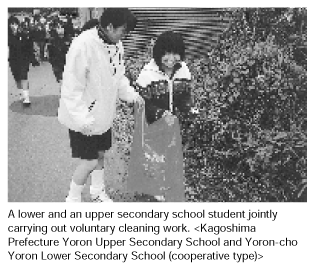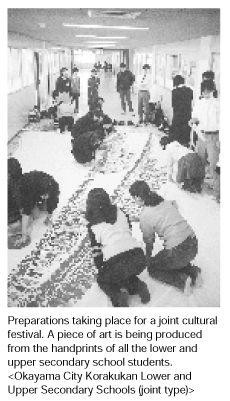| Home > Policy > White Paper, Notice, Announcement > White Paper > Japanese Government Policies in Education, Science, Sports and Culture 2000 > Trends in Educational Reform Section 2 Q8 Approximately how many schools will be established? | ||
At present, there are 17 unified lower and upper secondary schools, but the establishment of 15 such schools in 8 prefectures has already been announced for FY2001 (as of September 2000). Concrete steps are being taken in other prefectures also toward the introduction of unified lower and upper secondary school education.
In the future, we would like these kinds of schools to be established so that they are accessible to students and children's parents or guardians throughout Japan, and so that they are able to choose between conventional lower and upper secondary schools and unified lower and upper secondary schools. As there are approximately 500 school zones for public upper secondary school across Japan, the Ministry of Education, Science, Sports and Culture is committed to ensuring that approximately 500 schools are established across the country with at least one school, for the time being, in each school zone.


Although the phenomenon known as 'class disruption' is by no means occurring in a large number of schools, in February 1999, the Ministry of Education, Science, Sports and Culture (MESSC) commissioned the Committee on Class Management Research (composed of researchers from the National Institute for Educational Research of Japan and other institutions and related personnel who work at schools) to conduct research so that it could ascertain the true reality of this phenomenon. The research defined "occasions when a class in which the group education function of schools is continually ineffective for a certain period of time and develops into a situation where the problem cannot be remedied via the usual methods by the teacher in charge, for example, when children behave as they like in the classroom without obeying the teacher and the lesson cannot be carried out" as "circumstances in which the class does not function effectively." The research conducted interviews on those persons concerned regarding class management in elementary schools in regions across Japan. The findings of the interim summary released in September 1999 included the following: Furthermore, the Committee on Class Management Research has typified into 10 cases the examples it believed to be "circumstances in which the class does not function effectively" and observed their circumstances and possible measures. Case 1: Examples where there is a lack of cooperation and collaboration with pre-primary education facilities Case 2: Examples of children requiring special educational considerations and assistance Case 3: Examples of children not receiving necessary care at home Case 4: Examples of children dissatisfied with the lesson content and methods Case 5: Examples of delayed appropriate response to problem behavior, such as bullying Case 6: Examples where the leadership of the principal and cooperation and collaboration within the school is not established Case 7: Examples where class management of teachers lacks flexibility Case 8: Examples where relationships of trust have not been built owing to insufficient dialogue with the school and the family and response is delayed Case 9: Examples where the results of internal-school research and practical results are not fully brought to bear throughout the whole school Case 10: Examples where there existed problems of discipline at home and the response by the school
The committee subsequently proceeded with its research and surveys issuing its final report in March 2000. The final report gathers examples analyzing the overall trends of up to 150 classes, and at the same time also collects and examines examples of various attempts to try and restore class functions and their processes. Example 1: Restoration through class management that conforms to children's actual situations: Example 2: Restoration by rebuilding relationships of trust through changes in guidance perspectives: Example 3: Restoration through the use of joint lessons involving different school years, for example: Example 4: Restoration through cooperation and assistance among kindergartens/nurseries, elementary and lower secondary schools: Example 5: Restoration through comprehension of class conditions and assistance by children's parents or guardians: Furthermore, the final report presents the following six observations in order to cope with "circumstances in which the class does not function effectively": {1} First, acceptance of the situation {2} Attentive confrontation of the "difficulty" {3} Re-ascertainment of the view of the children {4} Fostering relationships of trust and enhancement of communication {5} Cross-border collaboration and cooperation with education and welfare, medical and other sectors {6} Passing down of customs of contemplation and experimentation, and wisdom, for example, by enhancing training and being creative and resourceful
Moreover, the final report lists the following five key points for future approaches: {1} Early assessment of the situation and early response {2} Establishment of appealing classes based on the children's reality {3} Establishment of a cooperative teaching system, such as TT, and use of intra-school organizations {4} Close cooperation with children's parents/guardians and others parties and unified approaches {5} Active cooperation with the board of education and other relevant organizations
The individual backgrounds and circumstances of the children at various times differ greatly in the examples illustrated in the report, and even the suggestions above may not always work. Still, we would like the examples presented in the report to be referred to in future approaches to class management and hope they will be useful. For your information, with regard to this issue, the MESSC is taking measures, including assigning part-time teachers, to render possible scrupulous teaching by more than one teachers. Prefectural boards of education, too, are working to assess the true situation within their respective jurisdictions, distributing teaching material and providing assistance through the holding of seminars, conferences, and other events. |
| Back to Top | MEXT HOME |